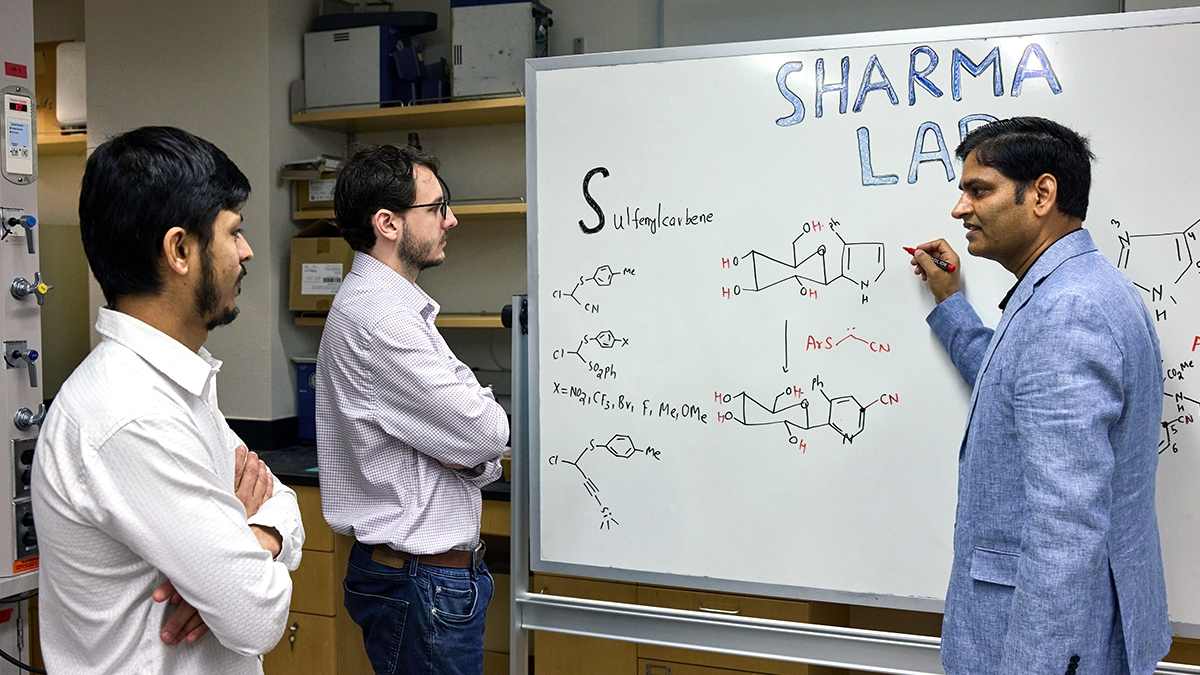Reviewed by Lexie CornerMay 7 2025
Researchers at the University of Oklahoma have developed a new method that could accelerate drug discovery and reduce pharmaceutical development costs. Published in the Journal of the American Chemical Society, the study introduces a safe, sustainable technique for adding a single carbon atom to drug molecules at room temperature.
 Indrajeet Sharma, right, with students Prakash Kafle and Deacon Herndon. Image Credit: Jonathan Kyncl.
Indrajeet Sharma, right, with students Prakash Kafle and Deacon Herndon. Image Credit: Jonathan Kyncl.
These carbon atoms serve as valuable points for further modification, allowing researchers to increase chemical diversity without disrupting sensitive structures.
Nitrogen atoms and nitrogen-containing rings, known as heterocycles, are key components in many medicines.
A team led by OU Presidential Professor Indrajeet Sharma has developed a method to modify these rings by inserting a single carbon atom using a fast-reacting chemical called sulfenylcarbene. This approach, known as skeletal editing, enables the conversion of existing molecules into new drug candidates.
By selectively adding one carbon atom to these existing drug heterocycles in the later stages of development, we can change the molecule’s biological and pharmacological properties without changing its functionalities. This could open uncharted regions of chemical space in drug discovery.
Indrajeet Sharma, Presidential Professor, University of Oklahoma
Previous approaches to similar carbon insertion reactions often relied on hazardous reagents, showed limited tolerance for functional groups, and posed safety challenges for large-scale pharmaceutical use.
In contrast, the team has developed a bench-stable reagent that generates sulfenylcarbenes under mild, metal-free conditions at room temperature, achieving yields of up to 98 %. Avoiding metal catalysts reduces both environmental and health risks, as many metals are known to have toxic effects.
The researchers are also exploring how this chemistry could be applied to DNA-encoded library (DEL) technology - a rapidly growing platform in pharmaceutical discovery that enables the screening of billions of small molecules for their ability to bind disease-relevant proteins.
Because this new carbon insertion method operates in water-compatible solvents and under gentle conditions, it is well suited for modifying DNA-linked compounds. Unlike other strategies that require harsh reagents or high temperatures, it preserves the delicate structures needed in DEL platforms.
Working in collaboration with the Damian Young group at Baylor College of Medicine, Sharma’s team aims to use this technique to expand chemical diversity and enhance biological relevance in DEL libraries. These are two significant drug discovery bottlenecks.
The cost of many drugs depends on the number of steps involved in making them, and drug companies are interested in finding ways to reduce these steps. Adding a carbon atom in the late stages of development can make new drugs cheaper. It is like renovating a building rather than building it from scratch. By making these drugs easier to produce at a large scale, we could reduce the cost of healthcare for populations around the world.”
Indrajeet Sharma, Presidential Professor, University of Oklahoma
Source:
Journal reference:
Kafle, P., et al. (2025) Sulfenylcarbene-Mediated Carbon Atom Insertion for the Late-Stage Functionalization of N-Heterocycles. Journal of the American Chemical Society. doi.org/10.1021/jacs.5c02012.